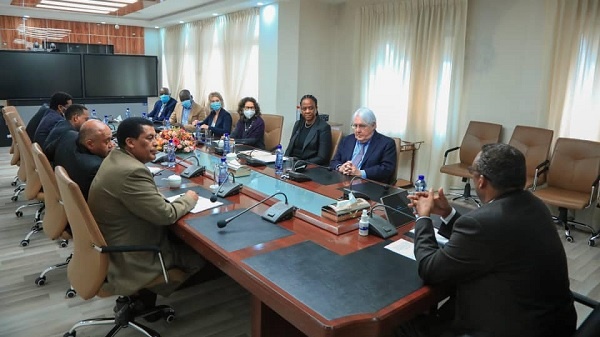
ADDIS ABABA (OCHA) – The Under-Secretary-General for Humanitarian Affairs and Emergency Relief Coordinator, Martin Griffiths, concluded his six-day visit to Ethiopia on the evening of 3rd August 2021, his first official mission since he assumed office in mid-July.
While in Ethiopia, the humanitarian chief held constructive meetings with the Federal Government, the Amhara regional president, the African Union, and the humanitarian and diplomatic community. During his meetings with the Prime Minister and other key interlocutors, including the Deputy Prime Minister/Minister of Foreign Affairs and the Minister of Peace, Mr. Griffiths had the opportunity to discuss the humanitarian situation in the country and the challenges aid organizations face in getting assistance to Ethiopians.
Mr. Martin Griffiths also spent two days in the Tigray region, where he saw first-hand the dire humanitarian situation, meeting with civilians whose lives had been upended by the conflict. “I met with people in Tigray who lost everything they had after they had to flee their villages or towns, leaving behind their houses and farms. In Hawzen, I visited a family whose house was burned and crops were looted. It was heart-breaking to see the scale of devastation and families who, to this day, do not have a place to live or food to put on their table,” said the humanitarian chief.
During his visit to Tigray, Mr. Martin Griffiths also met with civilians who had suffered horrific violence and saw first-hand the systematic destruction of civilian infrastructure, including schools, hospitals and water systems. In Mekelle and Freweyni, the humanitarian chief engaged with women who had endured unimaginable violence, including some who said they had been raped for weeks. These women need access to comprehensive and holistic services, and yet “this is happening at a moment where most health centers are not functional, like the hospital I visited in Hawzen, where almost nothing but the walls were left untouched; all equipment and medicines have to be replaced,” Mr. Griffiths said. The disruption of essential services, including access to communication, fuel and the banking system is compounding the dire situation.
More than 5.2 million people across Tigray—more than 90 per cent of the region’s population—require life-saving assistance, including nearly 400,000 people already facing famine-like conditions. Humanitarian needs are also increasing in neighboring Amhara and Afar, as the conflict spills over into these regions. In the face of increasing conflict and increasing difficulty getting aid into northern Ethiopia, the Under-Secretary-General said that “we need to change the circumstances that have led to the slow movement of aid – we need the conflict to stop.” Beyond Tigray, humanitarian organizations are assisting millions of people in Ethiopia facing conflict, displacement, and drought, and are now scaling up response efforts in Amhara and Afar, in light of significant conflict-related displacement. The humanitarian chief said: “It is my highest priority that every Ethiopian in humanitarian need – be they in Tigray, in Amhara, in Afar, or indeed in every region of this country – receive assistance.”
Source: OCHA
